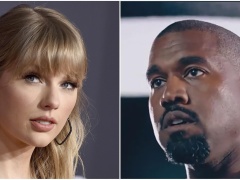
Since that time in his teens when he self-published the early ’90s graffiti art zine “Graphic Scenes & X-Plicit Language,” Sacha Jenkins has been about documenting hip-hop and funk culture — Black culture. Moving between print (he’s creative director at Mass Appeal), television (“Wu-Tang Clan: Of Mics and Men”) and film (“Bitchin’: The Sound and Fury of Rick James”), he’s documented the intricacies of African-American culture with dexterity and painstaking study (following in the footsteps of his late father, Horace Byrd Jenkins III, a crucial creator of the TV magazine format “Black Journal”).
Jenkins is also a musician, making the life and legacy of Louis Armstrong a fitting story for the director-writer-producer to tell. In “Louis Armstrong’s Black & Blues,” premiering today on Apple TV+, Jenkins documents the jazz trumpeter, vocal innovator and actor as a fire-starter for so much of what we hear now in Black music — rap included, thanks to Armstrong’s innovative rhythmic scatting – as well as being more of an activist than people realized where racism and the political upheaval of the Civil Rights Movement were concerned. Long criticized by Black artists of his time for elements of what Jenkins’ interviewee Wynton Marsalis calls “Tomming,” Jenkins portrays an Armstrong whose heart was heavy by such critiques, seeing as he fought long and hard for equality.
“Black & Blues” also includes powerful vintage clips and never-before-heard, self-made recordings of Armstrong speaking on reel-to-reel tapes from his den. Cutting, humorous correspondences and diary entries he wrote are read in voiceover by Jenkins’ friend, Nas.
Where did you and your family stand on the topic of Louis Armstrong during your formative years?
Growing up in Queens, there was an awareness of Armstrong — you knew that this important person lived there at one point. His records weren’t really played in my mom’s house. At my grandparents’ house in Philadelphia, however, very much so. Louis Armstrong and his wife actually remind me of my grandparents, the era they were from, and how they dressed and spoke.
Outside of that: I was a hip-hop kid. The music I was into was super aggressive and politically to the left. Louis Armstrong didn’t fit into that playlist. I only knew about him from what people told me, that he was a smiley guy who played his instrument well but shucked and jived for the White man. When you’re 16 and into Public Enemy, Louis Armstrong doesn’t make sense.
How did you come to be involved in an Armstrong documentary?
I’m a musician, a writer, a filmmaker and a journalist, and some of my best stories are on artists I didn’t know much about or necessarily care for initially. Like the major story I wrote on Bone Thugs-N-Harmony for Vibe. I didn’t know them. [It was], let’s see what happens. When the good people at Imagine called me up with the opportunity to do Armstrong — at that point I had done the series on Wu-Tang Clan and the film on Rick James, films that were in the music and culture space — I looked into him. When I did, I was so blown away by the fact that this guy was not the guy that I was told he was. The opportunity to tell such an important story about a man who, in so many different ways and so many different circles had been misrepresented and misunderstood was intoxicating. I delved into the research and what I found knocked me out.

What did you learn that went against the grain of what you’d originally thought?
The tapes that sat on a shelf for more than 40 years form a large part of the film and were crucial. He had a reel-to-reel machine, high technology at the time, and he taped conversations with his friends and recorded his own thoughts. When you hear in his own voice when he says to a friend, “When the fuck have I ever ‘Uncle Tommed?’” – there’s something about the way that he is saying it. He’s not saying it for an audience. He’s not performing for an audience. He’s talking to his man. Then I began thinking, “When did he actually Tom?”
Louis was a man of his times. Consider what and where he came from and what he had to face. What was he up against? What kind of special person would he have to be to overcome all that he went through to become who he became? This guy, then, is not who we thought he was. The hip-hop people of my generation, even Wynton Marsalis who we interviewed — he was into Louis and it was his dad who turned him onto Armstrong’s trumpet playing. There is this perception, of civil rights and Black Panthers, that he was of a different, vaudevillian time. The way that Black people in the 1960s saw themselves or wanted to see themselves… the way they saw Armstrong was foreign to them, that he was counterproductive to the struggle.
Now, looking back, we can see Armstrong in a different light. He wasn’t marching in the streets, but by telling fancy hotels who booked him — but wouldn’t let he or other Blacks sleep there — that if he played, he stayed. (Armstrong puts this codicil in his contract according to Jenkins’ film.) As a Black celebrity known [all over the world] at a time when there weren’t many like him, he was doing his thing. He just didn’t get the credit for it. So we could tell a story in this film that is engaging, revelatory and important.
Despite the fact that the film presents so many of his sonic innovations — the strong, repetitive high Cs, the scatting — people have said that there’s not as much music as they’d like in the documentary.
I used to be a music journalist. I can give you a whole lot of musicology. But. I believe that if you don’t understand the man, how are you going to understand the music? What’s germane to understanding Black music in America is understanding Black people. You can be a white jazz scholar who knows more about jazz than me and tell me that my film missed the mark, but I’ll tell you that white people don’t know what it is to be Black. Even if I’m Black now, I can’t pretend to know what he went through, what it was like to be Black in the South in the early 1900s. This film is a full portrait of who he was as a person.
There’s some musicology in the film, but, if, after seeing this you want to know about him blowing every high C, knock yourself out. This guy should be having his Basquiat moment right now. You can’t name anyone in the modern era that has as much talent as Louis Armstrong — he could sing, can play an instrument like no other. He’s writing his own biography. To have gone for so long as a reflection of the times he lived in, bucking the system in his own way on his own terms without recognition – it’s unbelievable.
Where does 1989’s “Satchmo” film stand for you, a documentary made by Gary Giddins, the white jazz journalist who touched on some of the elements of Armstrong’s personal life?
Look, Louis Armstrong is a great American who, as an American, made contributions to the world. But at the end of the day, he was a Black man, and the filmmaker that you speak of – I don’t know his race – but, I can tell you as a Black man and as a Black American what I thought was most important was having that conversation amongst us. This film is for everyone, but there are very specific internal conversations that are being had specifically for Black people. I don’t even know if it is a white person’s business to even care or not if Louis is an Uncle Tom. I don’t know that I want to hear from a white person whether or not Louis was an Uncle Tom. I’m sorry. It’s not a white person’s place to have that conversation. It’s a Black person’s place to have that conversation.
There is a poignant clip of Ossie Davis from 1981’s “With Ossie & Ruby” PBS show in your film, where he discusses reversing how he felt about Armstrong after working with him.
Ossie Davis is several generations removed from me, and he talked about how, at first, he had the same feelings about Louis Armstrong that my generation had. When he has his revelation about who he realizes that Armstrong really was — that’s powerful. That clip was tailor-made for this film and the conversation we wanted to have. Armstrong himself left so many nuggets in tapes and letters because he knew his story was important. I truly believe, deep in my heart, that Louis Armstrong co-directed this film. The things that he wanted people to know about him we were able to communicate because of so much great material that he left behind, material that amplifies his voice in many ways.
You use Nas as the voice of Armstrong in the film. Was there a sense of connecting the dots between your subject and hip-hop?
I have come to realize that when it comes to Black music in America, there is no real genre. What there is, is environment and a reflection of and a reaction to that environment. I did a Wu-Tang film, a Rick James film and a Louis Armstrong film and they have so many things in common. Louis Armstrong catches a gun charge and he goes away. RZA from Wu-Tang Clan had a serious gun charge that he was facing right before things started happening musically. Rick James went AWOL from the military, in and out of prison, right?
It’s the same story over and over again. Louis Armstrong reminded me of so many people that I grew up with in my neighborhood who were funny as hell, smart, creative, talented — but didn’t have the social capital. But there’s always somebody from the neighborhood who does good, who makes it out, who makes a splash. Nas and I are old friends. I tell him that I’m doing this film and he tells me that “What a Wonderful World” is his favorite song in the entire world. He loooves Louis Armstrong, and at that minute I knew I had to have Nas’ voice in “Black & Blues.” Nas is connected to Queens and community like Louis was connected to his area of New York and that community. Nas realized that Louis was like us, like he and I — talking about what is happening down the block. That’s how Louis explains “What a Wonderful World” in the film: seeing kids playing and families growing in his neighborhood. The connection lives on.






